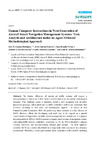Identificador persistente para citar o vincular este elemento:
https://accedacris.ulpgc.es/jspui/handle/10553/43963
| Título: | Human computer interactions in next-generation of aircraft smart navigation management systems: Task analysis and architecture under an agent-oriented methodological approach | Autores/as: | Canino-Rodríguez, José M. García-Herrero, Jesús Besada-Portas, Juan Ravelo-García, Antonio G. Travieso-González, Carlos Alonso-Hernández, Jesús B. |
Clasificación UNESCO: | 3307 Tecnología electrónica | Palabras clave: | Trajectory-Based Operations Air-Traffic-Control Conflict-Resolution Performance Automation, et al. |
Fecha de publicación: | 2015 | Editor/a: | 1424-8220 | Publicación seriada: | Sensors | Resumen: | The limited efficiency of current air traffic systems will require a next-generation of Smart Air Traffic System (SATS) that relies on current technological advances. This challenge means a transition toward a new navigation and air-traffic procedures paradigm, where pilots and air traffic controllers perform and coordinate their activities according to new roles and technological supports. The design of new Human-Computer Interactions (HCI) for performing these activities is a key element of SATS. However efforts for developing such tools need to be inspired on a parallel characterization of hypothetical air traffic scenarios compatible with current ones. This paper is focused on airborne HCI into SATS where cockpit inputs came from aircraft navigation systems, surrounding traffic situation, controllers' indications, etc. So the HCI is intended to enhance situation awareness and decision-making through pilot cockpit. This work approach considers SATS as a system distributed on a large-scale with uncertainty in a dynamic environment. Therefore, a multi-agent systems based approach is well suited for modeling such an environment. We demonstrate that current methodologies for designing multi-agent systems are a useful tool to characterize HCI. We specifically illustrate how the selected methodological approach provides enough guidelines to obtain a cockpit HCI design that complies with future SATS specifications | URI: | https://accedacris.ulpgc.es/handle/10553/43963 | ISSN: | 1424-8220 | DOI: | 10.3390/s150305228 | Fuente: | Sensors (Switzerland)[ISSN 1424-8220],v. 15, p. 5528-5550 |
| Colección: | Artículos |
Citas SCOPUSTM
9
actualizado el 08-jun-2025
Citas de WEB OF SCIENCETM
Citations
5
actualizado el 08-jun-2025
Visitas
126
actualizado el 24-nov-2024
Descargas
272
actualizado el 24-nov-2024
Google ScholarTM
Verifica
Altmetric
Comparte
Exporta metadatos
Los elementos en ULPGC accedaCRIS están protegidos por derechos de autor con todos los derechos reservados, a menos que se indique lo contrario.
